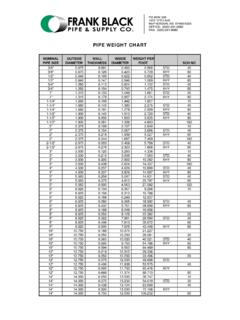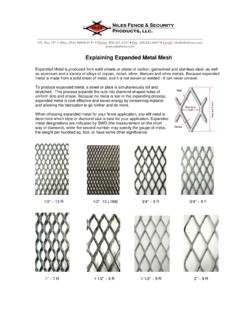Transcription of •Twist • Airfoils • Planform Shape • Span / Aspect Ratio ...
1 Wing Design: Major Decisions Wing Area / Wing Loading span / Aspect Ratio Planform Shape Airfoils Flaps and Other High Lift Devices Twist Wing Design Parameters First Level span Area thickness Detail Design Planform Shape Taper Sweep Tips Airfoils TwistFactors affecting wing size Cruise Drag Stall Speed Take off and landing distance Maneuver Instantaneous Sustained Fuel Volume Hangar sizeSpan Considerations Climb Induced drag important at climb airspeeds Greater span good for rate of
2 Climb Cruise High altitude: induced drag significant, greater span preferred Low Altitude: parasite drag dominates, span less important weight Increasing span and Aspect Ratio makes the wing heavier. Optimum is a compromise between wing weight and induced drag Ground Handling Taxiways and runway lights Hangar sizeWing Area Cruise Drag Low altitude cruise favors high wing loading and low wetted area. Higher altitude cruise favors lower wing loading and greater span . Takeoff and Landing Increasing wing loading increases takeoff and landing roll Roll is proportional to the square of the takeoff or landing speed Maneuvering Favors low wing loading, particularly for instantaneous turn rate.
3 Stall Speed Most light airplanes wings are sized by stall speed requirements FAR part 23, Part 103 SurvivabilityCruise Optimum WingFor a given altitude and airspeed:DD D CCbodymiscd wLSqeASq=+++.02 Differentiating wrt. wing area and setting derivative to zero gives:dwLCCeA02= This is the condition for best wingL/DAccordingly: for optimum cruise: size wingto fly at best wing L/DLoptd wCCeA=0 SWqeAdwC=/()0 Cruise Optimized WingWing Size Effect on L/D6789101112131415167080901001101201301 40150160170180190200 VkeasL/DAirplane with wing optimized for given equivalent airspeed does not fly at best airplane L/DOptimum Wing Loading: AR=7, Cd0=.
4 0080102030405060708010012515017520022525 0 True Airspeed (Knots)Wing Loading (Pounds per Square Foot)Sea Level7500 ,000 ,000 Speed Sized speed (knots)W/S=30 Clmax= Speed Drives Takeoff DistanceCRASH SURVIVABILITY010203040506070809040455055 6065707580 SPEED (KNOTS)IMPACT ANGLESURVIVABLE IMPACTNON-SURVIVABLE IMPACTW/S=10 STALLW/S=15W/S=20W/S=25W/S=30 CRASH SURVIVABILITY010203040506070809040455055 6065707580 SPEED (KNOTS)IMPACT ANGLESURVIVABLE IMPACTNON-SURVIVABLE IMPACTW/S=10 APPROACHW/S=15W/S=20 Wing thickness Wing weight is strongly affected by thickness , particularly for cantilever wings.
5 Thicker is lighter Supersonic wave drag is a strong function of t/c Variation of parasite drag with wing t/c is small at subsonic, subcritical speeds. Drag is primarily skin friction Large drag increase if wing gets so thick that flow separates thickness taper Wing weight most strongly affected by root depth Tapering t/c from root to tip can provide lighter wing for givenparasite Airflow Airfoil Generates Lift By Deflecting Streamlines Downward Momentum Change in Deflected Air Causes Pressure Changes That Act on Wing Air Flowing Over Upper Surface at Leading Edge Does Not Meet Neighbor Air at Trailing EdgeFlow Very Thick AirfoilFlow Over Very
6 Thin AirfoilsEffect of Airfoil thickness on DragTypical thickness DistributionsCamber EffectsEffects of Camber on LiftAngle of AttackClForward CamberAft CamberEffect of Camber on DragEffect of Camber on Airfoil Drag Wing Design Planform Shape Taper Compound Shapes or Curved Edges Sweep tips Taper Wing area Aspect Ratio TwistAerodynamic Center A point about which pitching moment does not vary with angle of attack. Typically near 25% chord for Airfoils in incompressible flow Moves aft at transonic Mach Numbers AC is at 50% chord for Airfoils at supersonic Mach NumbersSpan Loading span loading is comprised of 2 parts: Basic, and Additional: Basic span Loading: span loading when total wing lift=0 Primarily a function of twist and camber Zero everywhere for untwisted case.
7 Additional span Loading Lift due to angle of attack Linear function of AOA in attached, incompressible flow Primarily a function of Planform (chord distribution and sweep)Taper effects Positive Effects: Thicker Root Centroid of load moved inboard => reduced bending moment Lighter Structure More Volume Higher span Efficiency Not so Positive Effects: Structural Complexity High local Cl (additional) outboard Reduced Reynolds number outboard Poor Stall Characteristics PossibleSimple PlanformsConstant ChordStraight TaperCompound PlanformsConstant Chord Center Section ( Semi-Tapered)Compound TaperSweep Effects.
8 Delayed Drag Rise Aerodynamic Center Moved Aft Heavier Structure Increased Additional Loading (both CLC and Cl) outboard (Decreased for forward Sweep) Pitch up at stall Aeroelastic concernsInduced Drag(Drag Due to Lift) Induced drag is determined by weight , span loading, span efficiency. 1/2 of the total drag at best L/D 3/4 of the total drag at max. endurance (min. power) Most important in climb and high-altitude DragWing Deflects A Stream Tube of Air To Generate LiftStream Tube Diameter is Approximately the Wing span Stream Tube Size is Not Affected by Wing ChordInduced Drag is a Function of span Loading, Not Aspect RatioCdi= CL2/ eARAR = b2/S => Cdi= CL2 S/ eb2Di= CdiSq = CL2 S2q/ e b2 Multiplying by q/q gives: Di= CL2 S2q2/ e qb2CL2 S2q2=L2 Therefore :Di= L2/ eqb2 Induced Drag Example.
9 Redhawk Redhawk Advanced Technology Light Airplane Built From Cessna Cardinal New Wing With Advanced Features Higher Aspect Ratio Smaller Wing Area High Lift Devices Spoilers for Roll Control New Wing Had Less span Than Original Airplane Was Slower Than Stock at Cruise Altitude Very Poor Rate of ClimbReducing Induced Drag Reduce weight Increase span Increase span Efficiency (e) Wing Tips Some Improvement possible (~ 5%) Winglets and End Plates Induced Drag Decreased Parasite Drag Increased span Extension Usually Superior Improve Wing Root Junction Flow Poor Junction causes large loss of span efficiencyWing Tips Advancing tip: Vortex sheds outboardRetreating tip.
10 Vortex sheds inboardWing Root Junctions Air can get very confused Local separation / vortex shedding common A bad wing root junction increases bothparasite drag and induced drag Fillets and fairings Body shapingFlow Separation at a Wing RootImproved Junction Fairing Eliminates SeparationFully Attached Flow Stalls and Spins Stalls: What is a stall? Effect of angle of attack Effect of load factor Airfoil Effects 3D Effects Airplane Stall CharacteristicsStalls and Spins Stall/spin accidents are still a major problem.



